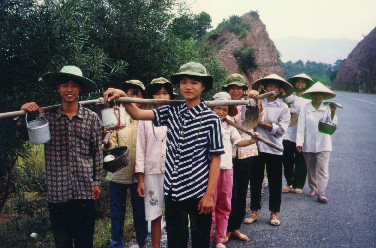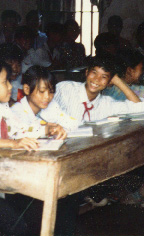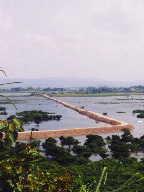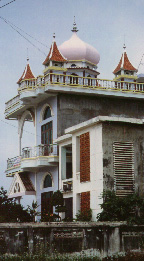

|
 A bicycle built for two -- and sometimes even three. (photo by rich beattie)
|
It was a very quiet morning in this neat little town. After breakfast, I wandered around the square in front of our hotel looking for a shop that sold film. A couple of places with photocopiers were open, but they had no film. Across the way, I saw a woman bringing out the trash from our hotel, and then loading the dishes from breakfast into her basket. Our morning's preparations went largely unobserved here, where it had drawn onlookers in the moderate-sized towns of Feng Cheng and Mong Cai. We rode through the narrow but neat back-streets of Tien Yen and down to the river on the far side of town, eliciting only a few glances from the early risers. Just in front of one shop two men were cutting lumber with a double saw. So far, the northeast corner of the country had proven to be decidedly low-tech compared to China. The road on the town side of the river was under construction, so we doubled back and crossed a bridge to the paved road on the other side. It was to be a short day -- maybe 25 miles -- because the guides had planned to have us ride the van through the coal towns along the coast. Here, we had been warned, we would be blackened with the dust, just as the laborers were.
|
|
 The teachers' room (above) and a classroom (below, by robert beckman). 
|
I was ready to take advantage of the morning's coolness and make quick work of the day, but the guides invited us to stop at an elementary school along the way. The children were in class, so we wandered over to the teachers' office, where we chatted with the school's English teacher, while her colleagues looked on. She mentioned that they were in need of books, as they relied at present on some rather basic primers.
The two primers in use were of the Jack and Jill variety, targeted to different grade levels with parallel Vietnamese and English phrases. I recall one of them beginning with an account of Jack's difficulty in rousing himself from bed to go to school. I took this as a very heartening sign that this weakness so well known to me had not been stamped out as a vestige of bourgeois decadence. I took down the teacher's address and promised to see what I could do to send her some books. Back in the schoolyard, class had let out, and a riotous crowd of kids surrounded the cyclists. I mingled for a few minutes, until (Manchurian) Dong quietly suggested that it was time to go. The hills and lush valleys suggested a slow-paced agrarian lifestyle,and so did the houses. We passed one where the main room was completely open to the road, with a motorcycle parked right next to bed.
|
|
 Dike along the coastline. |
It was getting quite hot very fast, as we descended to the coast, passed dykes that formed fishponds, crossed an old truss bridge and began a steep uphill. I found some shade on one side of the road where it cut a channel through the ridge top and let a nice breeze cool me off. Lowering the core temperature, I thought, that's the key. We worked our way inland, up a fairly steady grade that topped out around noon, and then I was sailing downhill. Towards the bottom of the descent, I came across the truck and a few riders. This was as far as we were to go that day. We waited a little while for the passenger van to double back, and exchanged a few priceless cyclists' secrets. (Did you know that there is actually an ointment product called "Chamois Butt-r"?) Getting on board, I noticed that Sen was gone. Well, I thought, it was to be expected. The handlers had probably noticed our mutual interest and had hurried her off to forestall a defection. And it was all for the best, from my point of view. I could see the whole plot unfolding -- the impetuous romance, smuggling her out in a duffel bag, the May-September marriage, the three-year wait for citizenship, and then the inevitable breakup. I had to thank my lucky stars that the Politburo had been on the case. Richard was travelling now with a box full of pith helmets. He had gotten a deal on a set of four that he just couldn't resist. "I have no idea what I'm going to do with these when I get back to Mississippi," he confessed. "Open a Richard's Pith Helmet Hut in downtown Greenwood," I suggested.
|
|
We noticed that many of the women who worked outside wore kerchiefs across their faces, much like our outlaws of the old West. We inquired as to the purpose -- to filter out the road dust? -- but were told that it was to protect against the sun. Lighter skin is considered more attractive. (photo by robert beckman). |
|
|
|
Not very far down the road, our bus pulled in to a combination bar and souvenir shop on a rise. This was apparently a popular roadside tourist stop. I took a look inside and saw a whole fleet of those ornate lacquered junks for sale. Nothing really struck my fancy, and they didn't have any stamps. Back outside, the others were sitting around on the shaded patio, drinking milk from coconuts and trying the "dragon fruit" (an exotic-looking delicacy, but without a distinctive taste). Johnny's coconut had a three-inch stem sticking out of it, and he regarded it with a wistful expression. "It's short but it's not very big around," he said, which I took to be an old Tutwiler saying. Our stopping-place was known informally as "Pee Ridge," because it was at a convenient midpoint for tourist buses on their way to and from China. On cue, a couple of buses rolled in, and the equivalent of the American Hawaiian-shirt crowd disembarked. "The ugly Chinese," Zhi Wei commented ruefully. It was our cue to get going.
|
|
|
The road through the coal fields at Cam Pha was in no wise as gloomy and grimy as we had been led to believe. It would have made for a long day, but we probably should have cycled all the way to Ha Long. The mines at Cam Pha are operated by Vinacoal (Vietnam National Coal Corp.) and are part of a national industry that produces as much as 11 million tons for coal-burning power stations, cement factories, and steelworks. About a third of the coal is exported. Conditions in the coal trade are as difficult and dangerous as in the turn-of-the-century Appalachians. One writer observes : "Working conditions in the mines, some of which are underground while the rest are massive pits up to 2 km deep, are stubbornly pre-modern." The houses and buildings around Cam Pha seemed different, many painted a yellow color that was different than the variety of pastels that had been (and would be) in vogue along the road that we were traveling. We were starting to see the karsts looming in the background, those peculiar limestone hummocks that poke straight up from the plain or the sea.
|
|
 The standard row house design, but topped with an onion dome that suggests other influences than the French. |
As we got closer to the city of Ha Long, the narrow 2 and 3-story buildings became rowhouses, as they had undoubtedly been intended. Most of them were open shops on the ground floor, selling a few necessities, beverages, toothpaste, and the like. It was a puzzling economy, certainly not communist, certainly not modern industrial capitalism or perfect free market. Here consumer choices were probably not driven by efficiency, selection, and price competition, but were more a matter of convenience, habit, and personal association. I would say it resembled the simple village economies I had seen in Switzerland, except that those mountain villages looked they had been set up by some typically fastidious bureaucrat, with exactly one boulangerie, one boucherie, etc. Here everybody had pretty much the same inventory -- a small selection of general necessities. Given the transportation parameters, would be a long time before one could imagine centralized supermarkets and department stores taking over. When you're on a three-speed bicycle and the shopping mall is 5 miles away over some hills, some of the thrill of discount pricing is lost. Maybe it would start the way the Migros chain started in Switzerland -- a truck would come to town once or twice a week, selling cheaper goods out the back. (And, as my mother told me, a family would always send the children over to buy things, so as not to appear to be violating their loyalty to the local merchant.) Once in Ha Long, we had lunch on the second floor of what we were told was the headquarters for Dong's travel company. While we were his first Americans, he assured us that he had guided a number of tours of Chinese to Hanoi and other venues in NVN. After lunch, we were told that we needed to get back on our bikes for a short ride to the ferry, the purpose of course being more promotional filming. At this point, I had tired of the promotional aspect of the tour. But we did it nonetheless; took a ten-minute ferry ride that put us within half-a mile of the hotel, where we found a small reception committee and -- more TV cameras! Johnny seemed a bit winded at this point, as well, so Richard did some of the spokesperson chores.
|
|
|
That night, we had dinner in the hotel and then set out in search of the "Emotions" cybercafe, rumored to be about kilometer and a half down the coastal avenue. This turned out to be a comparatively upscale venue, fully enclosed with an elegant bar just inside the entrance and about seven or eight computers in the adjoining room. I hacked around for nearly an hour, at a very reasonable charge of 40,000 dong or so (about $3). After that it was a long quiet walk back to the hotel, under sleepy trees and the occasional street light, with the salt air washing up as the waves rolled in to the dark shore to my right.
|